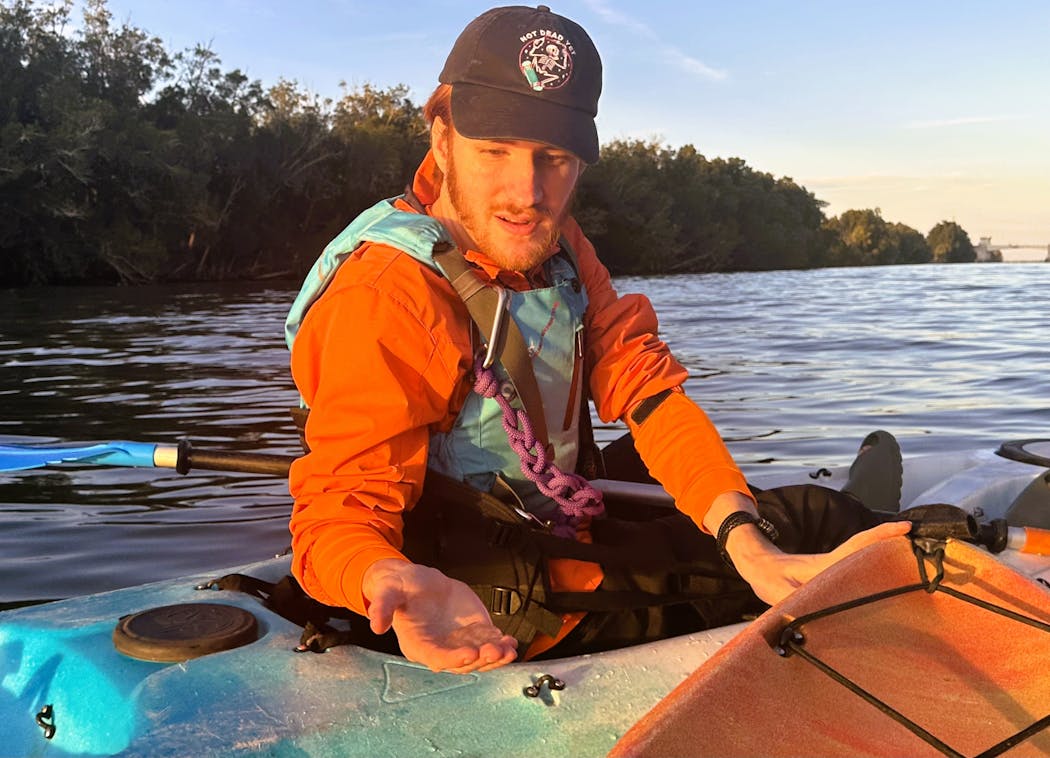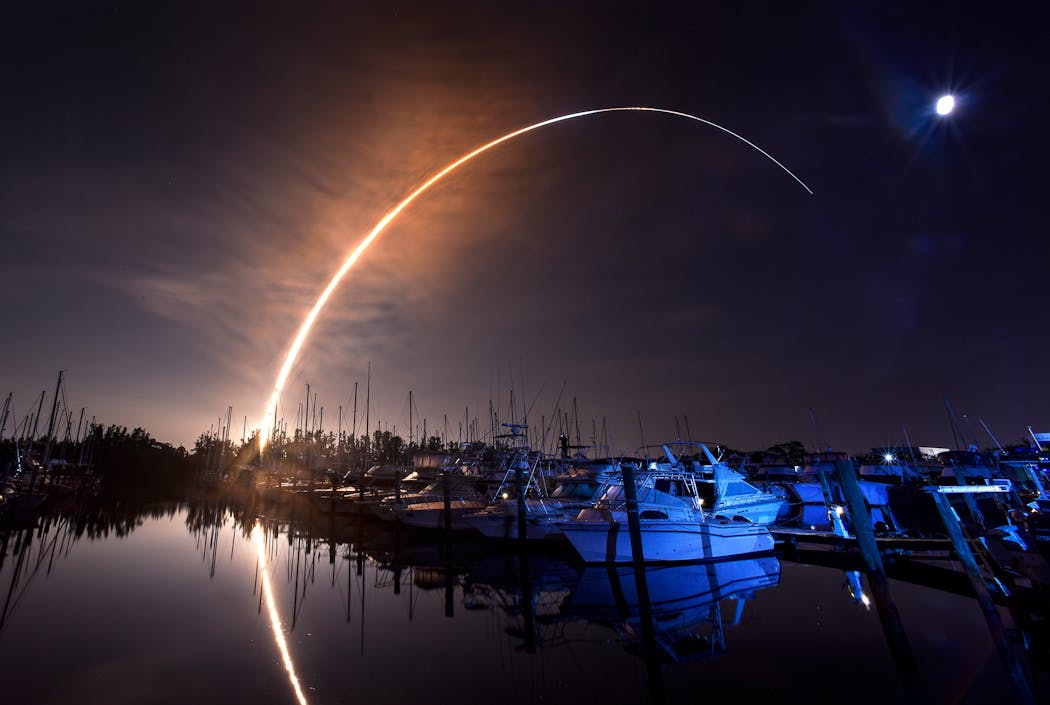As we stared into the interior waters of Florida's Space Coast, a transparent blob floated by so quickly, so faintly, that it could have been an illusion.
"I just saw a comb jelly!" our paddling guide, Kyle Moore of BK Adventures, had hollered minutes earlier.
My husband, Bob, and I gazed more intently to see the come-and-go creatures, looking a little like Pac-Man ghosts, swish by our kayak. We bobbed gently, surrounded by partly submerged mangrove trees and the 140,000-acre Merritt Island National Wildlife Refuge. The refuge adjoins the 58,000-acre Canaveral National Seashore, making this stretch of Florida near Kennedy Space Center delightfully wild and undeveloped.
With Orlando only 45 miles away, families do sometimes show up hoping wildlife will appear on cue, like theme-park animatronics.
"This bodes well for tonight," Moore said, as he scooped a walnut-sized comb jelly from the water to show us. We paddled closer to see this gelatinous invertebrate that doesn't sting or resemble what we think of as jellies.
Comb jellies comprise more than 100 species worldwide and are far simpler creatures. They've existed for at least 500 million years — long before humans evolved.
"It feels like someone sneezed into your hand — twice," joked Moore. "But they light up when you agitate them."
That's what drew us: the sunset paddle and night tour with the chance to witness bioluminescence for the first time.
As we waited for nightfall, we heard a loud "Phhhhtt!" as a dolphin surfaced nearby. It dove under and then jumped partway out of the water. At least a dozen osprey squabbled with one another, but we kept our ears attuned for the wet-snuffle sound of a manatee surfacing. We had seen a trio of the aquatic mammals from the refuge's observation deck that morning, before our afternoon on the refuge's Black Point Wildlife Drive.
During the drive, we constantly pulled over to watch alligators lurking in the grass, glossy and white ibis stabbing curved orange beaks into the water, and herons of all kinds prowling for food. Red-eyed, hot-pink-feathered roseate spoonbills preened in shallow waters, while squadrons of white pelicans arced overhead.
We wondered what would await us for the after-dark paddle.
Lighting up the night
"Open your fingers and swish your hands in the water," Moore told us as our eyes adjusted to nightfall. Looking down, we saw tiny sparkles swirling through our fingers and the warm water. Our daughter would have dubbed it "mermaid glitter."
"Those are the baby comb jellies," he explained. "They're tiny, like grains of sand." Full-sized, the comb jellies fit their nickname of "sea walnuts."
I paddled forward a few strokes, and Moore called out, "Did you see that?" A blue light flashed as my blade agitated an adult comb jelly. With a few nets, we scooped up jellies to place them into two fishbowls. I held a bowl briefly, swishing my fingers through the warm water, feeling the blobs and admiring their blue or blue-green flashes.
Comb jellies can usually be seen during the cooler months from November to as late as May. From May to November, night paddlers may see glowing blue-green clouds of single-celled, bioluminescent dinoflagellates.
Our group paddled across the lagoon and into a maze-like trail through mangroves, where we heard the splash of mullet jumping. As we paddled back, I paused to stare at the stars belting Orion and other constellations.
Moore helped us identify planes vs. orbiting satellites, and lights on the horizon where rocket launch pads and rocket-building facilities were located at Kennedy Space Center and Cape Canaveral.
"Some people are lucky and get to watch a rocket launch from here," Moore said.
We felt envious, but we were grateful enough to have seen a SpaceX Falcon 9 rocket launch at dusk a few days earlier from our condo rental in nearby New Smyrna Beach. It flared brightly and left a glowing squiggly contrail in its wake before disappearing.
After we pulled in our kayaks and studied the fishbowls of comb jellies one more time, we gently poured them back into the lagoon, triggering more flashes. That bit of ancient magic dazzled us — even so close to Florida's cusp of outer-space travel.
Getting there
The Space Coast is less than an hour east of Orlando International Airport; Sun Country also connects Minneapolis to Melboune Orlando International Airport on the coast.
Titusville is the gateway to Merritt Island National Wildlife Refuge and the Playalinda Beach (or southern unit) of Canaveral National Seashore. Access to Apollo Beach (or northern unit) of the national seashore can be reached from New Smyrna Beach.
Things to do
Last year broke records with 72 orbital rocket launches from Kennedy Space Center and Cape Canaveral Space Force Station. Elon Musk's ambitious SpaceX, along with NASA and United Launch Alliance, are on track to exceed that number this year. Look for launch countdowns and watch locations on sites such as spacelaunchschedule.com. Following the live YouTube coverage adds to the experience.
See retired rockets, join a virtual shuttle launch, and learn about space exploration at Kennedy Space Center, which packs in as many things to do as major theme parks. Tickets run $65-$75 — or $45 a day if you opt for a two-day pass.
Canaveral National Seashore, which hits its 50th anniversary next year, combines with Merritt Island National Wildlife Refuge for the longest stretch of undeveloped coastline in Florida. It provides vital nesting areas for threatened loggerhead and green sea turtles as well as endangered leatherbacks, Kemp's Ridley and hawksbill sea turtles. The park logged more than 16,600 nests last year, and rangers offer small-group, after-dark turtle-watch programs that fill quickly during the summer.
When temps dip below 68 degrees, head to Blue Spring State Park, 40 minutes inland from New Smyrna Beach. Park staff counted 641 manatees the day we visited in January as these grass-munching "sea cows" sought much-needed warmth in the 72-degree springs. The clear spring water and viewing decks made it easy to see schools of fish and dozens of manatees looking like elongated boulders until they rose for air.
BK Adventure Florida is among a few outfitters offering bioluminescent kayaking tours, but it also has daytime paddles for seeing dolphins and manatees starting at $52.
Where to eat
New Smyrna Beach's Third Wave Cafe & Wine Bar serves breakfasts such as strawberry-stuffed crepes or shrimp and grits, along with wood-fired Neapolitan pizza, local catches and small plates on an outdoor patio.
JB's Fish Camp, near the national seashore's Apollo Beach entrance, serves Southern seafood specialties with a little kick — like jalapeños in the deep-fried cornmeal hush puppies and crab-stuffed flounder. The business also rents kayaks, books live bands and faces west for sunset views along the Indian River.
Where to stay
Find condos, rental homes and hotels in New Smyrna Beach, or in Titusville and Cocoa Beach for closer access to the refuge and Kennedy Space Center.
St. Cloud-based Lisa Meyers McClintick (@minnelisa on Instagram) has written travel features for the Star Tribune since 2001.
Singing, ceremonies and straw hats: Olympics opening ceremony in Tahiti centers Polynesian culture

Three 101-year-old friends recall fond memories in 1940s Alexandria
Celine Dion makes musical comeback at Paris Olympics with Eiffel Tower serenade




